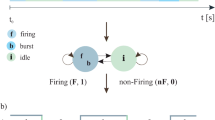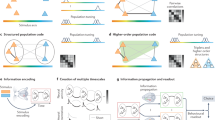Abstract
The action potentials (impulses) produced by pairs of neighboring retinal ganglion cells often show a tendency either to fire in close temporal synchrony or to avoid temporal synchrony. This cross-correlation (a rate of ‘‘coincidences’’ that differs from that expected by chance) has been exploited as a window into retinal processing, but its possible functional significance has proven elusive. Previous work has failed to show that the coincidences serve as a direct code for visual stimuli. In this analysis it is shown that the coincidences serve neither as a key for reducing variability nor as a key for improving the coding by the individual cells. The residual impulse trains (trains with coincidences deleted) are more variable than the raw impulse trains and provide an inferior coding to that of the raw impulse trains. There is negative correlation between the firing rate of the residual impulse trains and that of the coincidence impulse trains, which is consistent with the lower variance of the raw impulse trains. There is no consistent cross-correlation between the rates of residual impulse trains of cells in pairs showing cross-correlation; however, it is found that this observation does not discriminate among models for generating coincidences.
Similar content being viewed by others
References
Amit DJ (1989) Modeling brain function. Cambridge University Press, Cambridge, UK
Arnett DW (1978) Statistical dependence between neighboring retinal ganglion cells in goldfish. Exp Brain Res 32:49–53
Arnett D, Spraker TE (1981) Cross-correlation analysis of the maintained discharge of rabbit retinal ganglion cells. J Physiol Lond 317:29–47
Barlow RB, Birge RR, Kaplan E, Tallent JR (1993) On the molecular origin of photoreceptor noise. Nature 366:64–66
Brivanlou IH, Warland DK, Meister M (1998) Mechanisms of concerted firing among retinal ganglion cells. Neuron 20:527–539
Burton RM, Mpistos GJ (1992) Event-dependent control of noise enhances learning in neural networks. Neural Netw 5:627–637
Eger M, Eckhorn R, Schanze T, Wilms M (2001) Temporal, spatial, and intensity information in cat visual cortex evoked by a retina-implant. In: Neural Coding 2001, Plymouth, Devon, UK, 11 September 2001
Ginsburg KS, Johnsen JA, Levine MW (1984) Common noise in the firing of neighbouring ganglion cells in goldfish retina. J Physiol Lond 351:433–450
Johnsen JA, Levine MW (1983) Correlation of activity in neighbouring goldfish ganglion cells: relationship between latency and lag. J Physiol Lond 345:439–449
Kelso JAS (1995) Dynamic patterns: the self-organization of brain and behavior. MIT Press, Cambridge, MA
Knight BW (1972) Dynamics of encoding in a population of neurons. J Gen Physiol 59:734–766
Levine MW (1997) An analysis of the cross-correlation between ganglion cells in the retina of goldfish. Vis Neurosci 14:731–739
Levine MW (1998) Models for the cross-correlation between retinal ganglion cells. Biol Cybern 79:367–376
Levine MW, Saleh EJ, Yarnold PR (1988a) Statistical properties of the maintained discharge of chemically isolated ganglion cells in goldfish retina. Vis Neurosci 1:31–46
Levine MW, Zimmerman RP, Carrión-Carire V (1988b) Variability in responses of retinal ganglion cells. J Opt Soc Am A 5:593–597
Levine MW, Cleland BG, Zimmerman RP (1992) Variability of responses of cat retinal ganglion cells. Vis Neurosci 8: 277–279
Levine MW, Cleland BG, Mukherjee P, Kaplan E (1996) Tailoring of variability in the lateral geniculate nucleus of the cat. Biol Cybern 75:219–227
Levine MW, Castaldo K, Kasapoglu MB (2002) Firing coincidences between neighboring retinal ganglion cells: inside information or epiphenomenon? Biosystems 67:139–146
Löwel S, Singer W (1992) Selection of intrinsic horizontal connections in the visual cortex by correlated neuronal activity. Science 255:209–212
Maffei L, Galli-Resta L (1990) Correlation in the discharges of neighboring rat retinal ganglion cells during prenatal life. Proc Natl Acad Sci USA 87:2861–2864
Mainen ZF, Sejnowski T (1995) Reliability of spike timing in neocortical neurons. Science 268:1503–1506
Mastronarde DA (1983) Interactions between ganglion cells in cat retina. J Neurophysiol 49:350–365
Meister M (1996) Multineuronal codes in retinal signaling. Proc Am Acad Sci 93:609–614
Meister MM, Lagnado L, Baylor DA (1995) Concerted signaling by retinal ganglion cells. Science 270:1207–1210
Nirenberg S, Carcieri SM, Jacobs AL, Latham PE (2001) Retinal ganglion cells act largely as independent encoders. Nature 411:698–701
Panzeri S, Pola G, Petroni F, Young MP, Petersen RS (2002) A critical assessment of different measures of the information carried by correlated neuronal firing. Biosystems 67:177–185
Perkel DH, Gerstein GL, Moore GP (1967) Neuronal spike trains and stochastic point processes: II. Simultanteous spike trains. Biophys J 7:419–440
Raymond SA (1979) Effects of nerve impulses on threshold of frog sciatic nerve fibers. J Physiol Lond 290:273–303
Samonds M, Brown HA, Bonds AB (2004) Relationships between the spatiotemporal structure of spike trains and cortical synchronization. In: Vision Sciences Society annual meeting 2004, Sarasota, FL, 1 May 2004
Schellart NAM, Spekreijse H (1973) Origin of the stochastic nature of ganglion cell activity in isolated goldfish retina. Vision Res 13:337–345
Schmidt JT, Buzzard M (1990) Activity-driven sharpening of the regenerating retinotectal projection: effects of blocking or synchronizing activity on the morphology of individual regenerating arbors. J Neurobiol 21:900–917
Segundo JP, Vibert J-F, Pakdaman K, Stiber M, Diez Martinez O (1994) Noise and the neurosciences: a long history, a recent revival and some theory. In: Pribram KH (ed) Origins: brain and self organization. Lawrence Erlbaum, Hillsdale, NJ, pp 300–331
Shatz C (1996) Emergence of order in visual system development. Proc Natl Acad Sci USA 93:602–608
Tolhurst DJ, Movshon JA, Thompson ID (1981) The dependence of response amplitude and variance of cat visual cortical neurones on stimulus contrast. Exp Brain Res 41:414–419
Tolhurst DJ, Movshon JA, Dean AF (1983) The statistical reliability of signals in single neurons in cat and monkey visual cortex. Vision Res 23:775–785
Weliky M, Katz LC (1997) Disruption of orientation tuning in visual cortex by artificially correlated neuronal activity. Nature 386:680–685
Author information
Authors and Affiliations
Corresponding author
Rights and permissions
About this article
Cite this article
Levine, M. The potential coding utility of intercell cross-correlations in the retina. Biol. Cybern. 91, 182–187 (2004). https://doi.org/10.1007/s00422-004-0492-4
Received:
Accepted:
Published:
Issue Date:
DOI: https://doi.org/10.1007/s00422-004-0492-4




